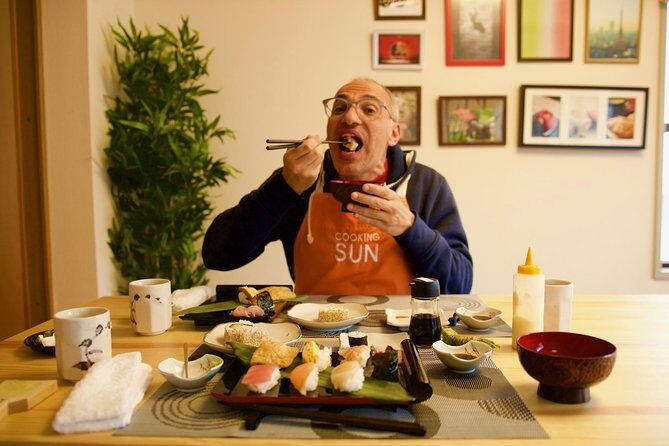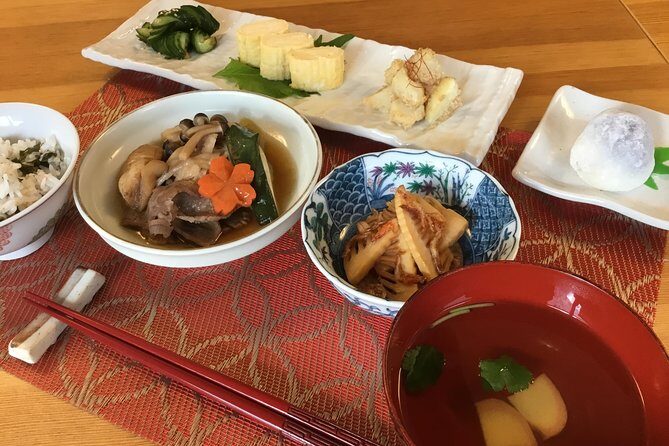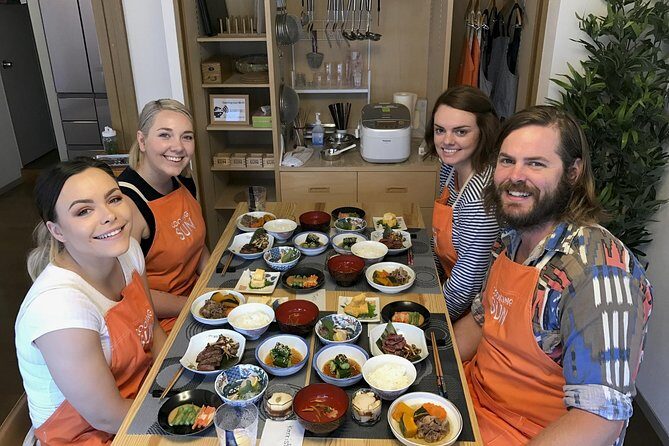Discover the exciting world of the ‘Small-Group Wagyu Beef and 7 Japanese Dishes Tokyo Cooking Class.’ Led by experienced instructors, this hands-on culinary experience in the heart of Tokyo offers personalized attention and guidance.
From mastering the art of cooking authentic Japanese dishes to savoring the exquisite flavors of Wagyu beef, participants can indulge in Japan’s rich culinary heritage.
Whether a seasoned chef or a passionate food enthusiast, this unique cooking class promises to expand your skills and delight your taste buds.
Key Takeaways

- Learn cooking techniques to enhance the flavor of Wagyu beef
- Discover the proper way to sear the beef for a juicy and tender result
- Explore marinating techniques to enhance natural flavors and texture
- Gain valuable tips on achieving the perfect level of doneness
The Art of Cooking Wagyu Beef

The instructor teaches the participants the art of cooking the Wagyu beef to perfection. In this cooking class, you will learn various cooking techniques that enhance the unique flavor of Wagyu beef.
The instructor will demonstrate the proper way to sear the beef, ensuring a juicy and tender result. They’ll also teach the participants how to marinate the meat to enhance its natural flavors and melt-in-your-mouth texture.
Plus, you will learn about different seasoning techniques to complement the rich, buttery taste of Wagyu beef. The instructor will provide valuable tips on achieving the perfect level of doneness, whether it be medium-rare or well-done.
Exploring Traditional Japanese Dishes

Traditional Japanese cuisine is known for its use of fresh and seasonal ingredients, which not only enhance the flavors but also reflect the cultural significance of Japanese cuisine. Here are some key aspects of traditional Japanese dishes:
- An emphasis on simplicity and balance: Traditional Japanese dishes focus on highlighting the natural flavors of the ingredients, using minimal seasoning to allow the true essence of the food to shine through.
- Use of traditional Japanese ingredients: From soy sauce and miso paste to seaweed and tofu, traditional Japanese dishes incorporate a range of ingredients that have been staples in Japanese cooking for centuries.
- Attention to presentation: Japanese cuisine places great importance on the visual appeal of a dish. Each plate is meticulously arranged to create a harmonious and aesthetically pleasing presentation.
- Seasonal and regional variations: Japan’s diverse climate and geography have given rise to a wide range of regional dishes, each showcasing the unique flavors and ingredients of that particular area.
- Preservation of culinary traditions: Traditional Japanese dishes are deeply rooted in history and have been passed down through generations. The preservation of these culinary traditions not only honors the past but also keeps the culture alive for future generations to enjoy.
Unveiling the Secrets of Tokyo Cuisine
Uncovering Tokyo’s culinary heritage is an adventure in experiencing authentic Japanese flavors. From delicate sushi to hearty ramen, Tokyo offers a wide range of dishes that showcase the rich history and cultural diversity of Japanese cuisine.
With its vibrant food markets, Michelin-starred restaurants, and traditional izakayas, the city is a treasure trove of culinary delights waiting to be explored. Whether it’s trying out the art of sushi-making, indulging in a bowl of steaming hot ramen, or sampling the exquisite flavors of wagyu beef, Tokyo promises an unforgettable gastronomic journey.
A Culinary Journey Through Japan’s Flavors

Indulging in a culinary journey through Japan’s flavors offers a delectable exploration of the country’s diverse and enticing cuisine. From traditional dishes to modern fusion creations, Japanese cooking is a captivating mix of flavors, techniques, and influences. Here are five key aspects to consider when delving into the world of Japanese flavors:
- The Influence of Foreign Cuisines: Japanese cooking has been greatly influenced by foreign cuisines, such as Chinese, Korean, and Portuguese. These culinary exchanges have resulted in the incorporation of new ingredients, flavors, and cooking techniques.
- Health Benefits of Traditional Japanese Ingredients: Traditional Japanese ingredients like seaweed, miso, tofu, green tea, and fish provide numerous health benefits. They’re rich in vitamins, minerals, antioxidants, and omega-3 fatty acids, contributing to a balanced and nutritious diet.
- Umami: The fifth basic taste, umami, is highly valued in Japanese cuisine. It adds depth and savory flavor to dishes, often achieved through ingredients like soy sauce, mushrooms, and fermented products.
- Seasonality: Japanese cooking celebrates the changing seasons, with ingredients and dishes carefully selected to reflect the time of year. This emphasis on seasonality ensures the freshest and most flavorful ingredients are used.
- Presentation: Japanese cuisine places great importance on the presentation of food. Each dish is beautifully arranged, capturing the essence of simplicity, balance, and elegance.
Embarking on a culinary journey through Japan’s flavors not only tantalizes the taste buds but also provides a deeper understanding of the country’s rich culinary heritage, the influence of foreign cuisines, and the health benefits of traditional Japanese ingredients.
Mastering the Techniques of Japanese Cooking

They can enhance their culinary skills by mastering the techniques of Japanese cooking.
Japanese cooking techniques have a rich history and are an integral part of traditional Japanese cuisine. From delicate knife skills to precise temperature control, these techniques are designed to bring out the natural flavors of the ingredients and create visually stunning dishes.
One such technique is ‘umami,’ which refers to the fifth taste sensation that’s unique to Japanese cuisine. It involves using ingredients such as soy sauce, miso, and seaweed to enhance the savory flavors of a dish.
Another technique is ‘tempura,’ which involves lightly battering and frying seafood and vegetables to create a crispy and delicious dish.
Savoring the Delights of Wagyu Beef

She eagerly relished the tender, melt-in-your-mouth texture of Wagyu beef, and it left her craving for more.
Wagyu beef, known for its exceptional marbling and rich flavor, is a delicacy that has captured the attention of food enthusiasts worldwide. The preparation of Wagyu beef is meticulous, with farmers dedicating time and effort to ensure the highest quality. The cattle are raised in a stress-free environment, fed a carefully curated diet, and given ample space to roam.
When it comes to tasting Wagyu beef, the experience is unparalleled. Each bite is a symphony of flavors, with the meat practically dissolving on the palate. The intense umami taste, combined with the buttery texture, creates a sensory explosion that’s hard to forget. Whether enjoyed as a steak, in a hotpot, or even as sushi, Wagyu beef is a culinary experience that’s truly one-of-a-kind.
Discovering Tokyo’s Gastronomic Treasures
Visiting Tokyo offers the opportunity to explore and uncover the gastronomic treasures the city has to offer. The bustling metropolis is known for its diverse culinary scene, where gastronomic adventures and culinary exploration await. From world-renowned sushi and sashimi to delectable ramen and tempura, Tokyo’s food culture is a feast for the senses.
One can embark on a culinary exploration through the city’s vibrant food markets, such as Tsukiji Fish Market or Ameya-Yokocho Market, where an array of fresh seafood, local produce, and street food can be found. For a unique dining experience, visitors can indulge in traditional kaiseki cuisine, which showcases the artistry and precision of Japanese culinary techniques.
Tokyo is also home to numerous Michelin-starred restaurants, offering exquisite and innovative dishes that push the boundaries of gastronomy. Whether it’s dining at a hidden izakaya, slurping noodles at a local ramen joint, or trying out the latest food trends, Tokyo promises a culinary adventure like no other.
Frequently Asked Questions
How Long Is the Small-Group Wagyu Beef and 7 Japanese Dishes Tokyo Cooking Class?
The small-group Wagyu beef and 7 Japanese dishes Tokyo cooking class lasts approximately 3 hours. Participants will learn the benefits of cooking wagyu beef at home and receive top tips for cooking Japanese dishes at home.
Are There Any Age Restrictions for the Cooking Class?
There are no age restrictions for the cooking class. The class duration is approximately [insert duration]. It’s a great opportunity for all ages to learn about Japanese cuisine and enjoy a hands-on cooking experience.
What Is the Meeting Point for the Cooking Class?
The meeting point for the cooking class is not specified. Recommended transportation options are not provided.
Is There a Dress Code for the Cooking Class?
There is no specific dress code mentioned for the cooking class. However, it is recommended to wear comfortable clothing and closed-toe shoes. Aprons and all necessary cooking equipment will be provided.
Can I Take Home the Recipes for the Dishes I Learn to Cook in the Class?
Yes, participants can take notes during the cooking class to remember the recipes for the dishes they learn to cook. However, the class does not offer a specific sharing of recipes.
The Sum Up
To sum it up, the Small-Group Wagyu Beef and 7 Japanese Dishes Tokyo Cooking Class is a must-try culinary experience for anyone interested in mastering the art of Japanese cuisine. With experienced instructors and a hands-on approach, participants can expect personalized attention and guidance throughout the session. From learning the techniques of Japanese cooking to savoring the exquisite flavors of Wagyu beef, this class offers a comprehensive exploration of Japan’s rich culinary heritage. Don’t miss the chance to expand your culinary skills and indulge in the delicious flavors of Japan.
- Khmer Cooking Class at a Local’s Home in Krong Siem Reap: Experience the authentic flavors of Khmer cuisine in a local’s home in Krong Siem Reap.
- 5 Traditional Dishes Hanoi Cooking Class with Market Trip: Enjoy the vibrant culinary scene of Hanoi and learn to cook traditional Vietnamese dishes.
- Half-Day Cooking Class in Thamel, Kathmandu: Discover the unique flavors of Nepali cuisine in a half-day cooking class in Thamel, Kathmandu.
These cooking classes offer unique experiences and insights into different Asian cuisines. Be sure to check them out for a diverse culinary adventure.






